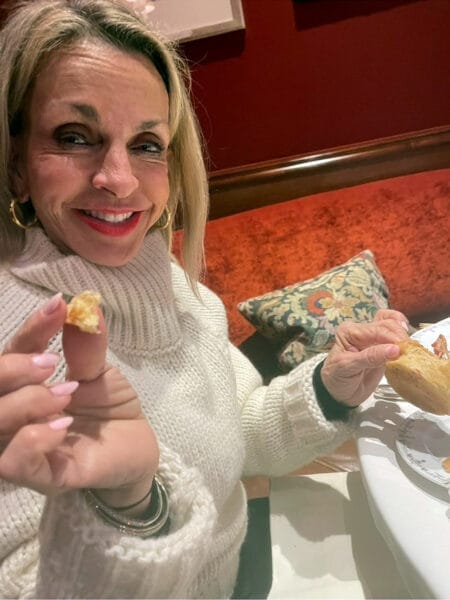You may have heard of the term “breaking bread” loosely used in connection to gatherings around the dinner table. However, did you know that this terminology is actually the correct way to eat a roll or piece of bread? In this post, I will delve into the proper table manners surrounding the bread plate and what you should do to follow the rules of dining etiquette. Bon Appétit!
Dining Etiquette is About the Details
 Of course, before starting to eat, one should begin with thanksgiving and gratitude for the meal. This is the first and foremost rule of dining! In all my classes, the meal begins with silence or Thanks to God for the food that has been placed before us.
Of course, before starting to eat, one should begin with thanksgiving and gratitude for the meal. This is the first and foremost rule of dining! In all my classes, the meal begins with silence or Thanks to God for the food that has been placed before us.
Once this has been completed, it’s time to start passing the food. Below are a few guidelines for managing your dinner rolls or bread at the table.
- The first rule of eating bread is to remember that your bread plate is always on your left.
- Your bread should always be pinched and eaten one bite at a time. Never eat a piece of bread as a whole or break it into two pieces.
- Never cut your roll or bread.
- Do not eat bread before, between or after each meal course.
- Always serve butter to your bread plate so you can easily add butter to your bread one bite at a time. Never butter your entire roll.
- Bread must be pinched with your fingers.
- If you take a piece of bread, you must eat it.
Toast and Bagels – Buttered and eaten similar to above, except each bagel or slice of toast should be cut into two pieces and jam or cream cheese spread lightly over one half.
Muffins – Muffins or soft bread should be broken in half with fingers. A bite-sized piece is taken from the broken half and one piece at a time is buttered for eating.
Breadsticks – Breadsticks should be broken in half and butter is not necessary.
Croutons – Should never be eaten with fingers. If a crouton is hard, it should be scooped up with a spoon and, if soft, needs to be handled with a fork.
Again, the bread plate is to your left and should always be on the left. If you don’t have a bread plate at the table, place your bread on the upper left corner of your plate…never on the table! Your bread plate can be used to discard any unwanted food item such as a seed from an olive or a rotten bite of food.
These rules of etiquette apply to England, but in France, things are a little different. The French do not use a bread plate. Instead, bread served with a meal can be placed directly on the tablecloth or on the upper left side of your plate.
Want to Learn all the Secrets for Proper Table Manners?
 Being mindful of how and what kind of bread you are eating is a vital part of table manners and proper dining etiquette! Lisa Burdette is a trained Dining Etiquette Expert in the Dallas area. She works with families, young children, individuals and teams of business professionals to help them succeed at home, school and work.
Being mindful of how and what kind of bread you are eating is a vital part of table manners and proper dining etiquette! Lisa Burdette is a trained Dining Etiquette Expert in the Dallas area. She works with families, young children, individuals and teams of business professionals to help them succeed at home, school and work.
Questions? Or, are you ready to book your private or group session? Lisa is glad to customize her classes to meet each of her client’s needs. Book online or send a message via our Contact page to request your session with our etiquette expert today!

